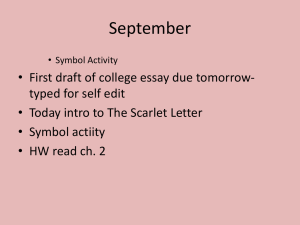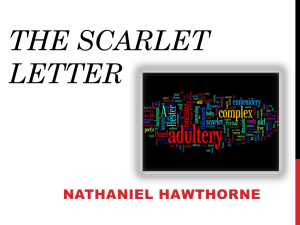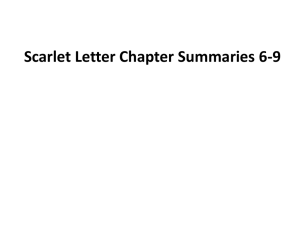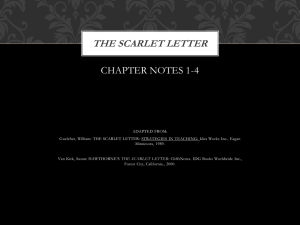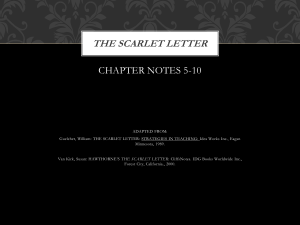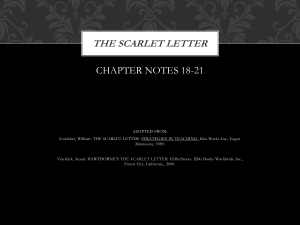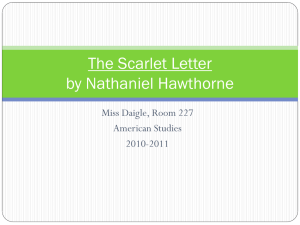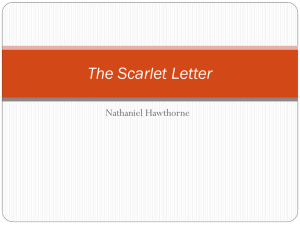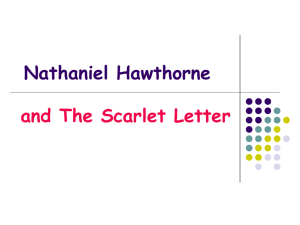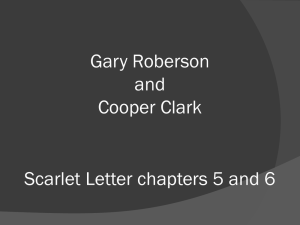The Scarlet Letter - Darien Public Schools
advertisement
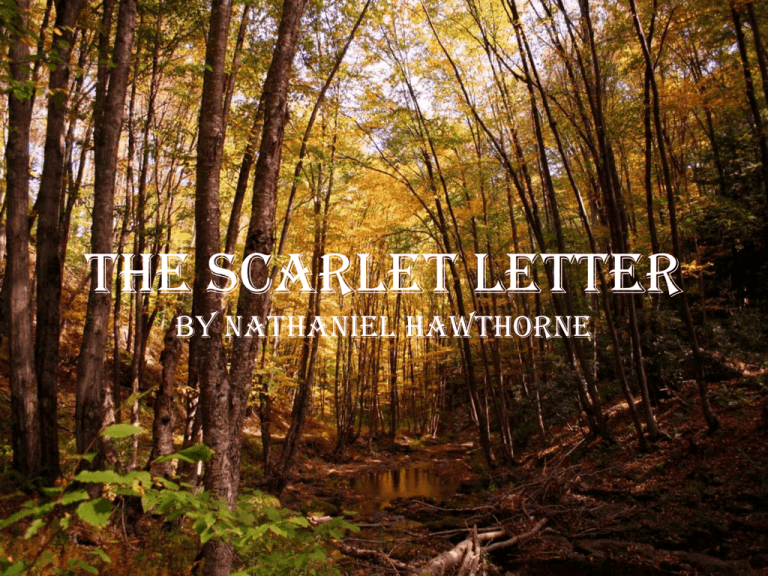
The Scarlet Letter By Nathaniel Hawthorne Hawthorne’s Frame Story Frame Narrative or Story: A story in which another story is enclosed or embedded as a “tale within the tale,” or which contains several such tales. Prominent examples of frame narratives enclosing several tales are Boccaccio’s Decameron (1353) and Chaucer’s Canterbury Tales (c. 1390), while some novels such as Mary Shelley’s Frankenstein (1818) and Emily Bronte’s Wuthering Heights (1847) employ a narrative structure in which the main action is relayed at second hand through an enclosing frame story. Can you think of any other books or movies that have “frame stories”? The Custom House Read excerpts aloud: 1. 2. 3. 4. 5. 6. 7. Pg 1: What can we determine about our narrator? Pg 2-3: What is the setting? How does the description of the wharf contrast with the description of the Custom House building? Why might Hawthorne highlight this contradiction? Pg. 25-26: Where does the narrator discover the source material for the story to follows? How long ago was it deposited here, and where did it come from? Pg. 27: What object particularly interests the narrator? What effect does it have on him? Pg. 28: Who will this story be about? In what time and place did she live? How “authentic” will the following account be? Pg. 29: What imaginary scenario does the narrator use to explain the feeling he has about writing this story?” How does all of this impact us as readers and affect out expectations of the story to follow? HW: Read the Introduction to Nathaniel Hawthorne in your Romanticism Reader and note any connections between the author and the narrator he creates for The Scarlet Letter. Chapter 1: “The Prison Door” Reading “The Prison Door” Listen carefully to the first chapter of The Scarlet Letter. Lightly mark any words you don’t know or statements you don’t understand on a literal level. Imagining “The Prison Door” Listen carefully to the first chapter of The Scarlet Letter. Try to visualize the scene as an opening credit sequence in a film. Ask yourself the following questions: – What seem to be the key images (or "shots")? – How would I characterize the mood of this chapter? – Is there any relationship between the mood and the images presented? – What does Hawthorne seem to be preparing us for? What type of story will this likely be? Storyboarding “The Prison Door” 1. Free-write for one page, describing the mood you want to capture and the details and images you will focus on to convey that mood. What kinds of shots would you use? What kind of camera angles/movement might you want? What kind of lighting? Colors? Sounds? 2. Storyboard at least six frames for the opening sequence. HW: Read Chapters 2 and 3 Chapters 2 and 3: “The MarkeT Place” and “The recogniTion” The Scarlet Letter, ch. I-III Identify a passage from the first few chapters that you feel is helpful in understanding Hawthorne’s tone, one that makes clearer Hawthorne’s attitudes about this place and its people. What does this passage reveal to us? What might it help us understand? Hawthorne’s Language Techniques to understand and look for: • Contradiction • Juxtaposition • Ambiguity Hawthorne’s Language: Contradiction A contradiction is a discrepancy in the text, when a statement opposes previous statements. • E.g. “The man stood bravely in front of his enemies, but trembled inwardly.” – • In Chapter 1, the immediate establishment of a cemetery and a prison contradicts the goal of creating a utopian society. Notice the frequency with which Hawthorne contradicts himself as he describes characters and events, often using words like “yet,” “but,” “albeit,” “however,” “despite,” “in spite of,” “be that as it might,” etc. Hawthorne’s Language: Contradiction Juxtaposition occurs when two images that are otherwise not commonly brought together appear side by side. • • E.G. “He slouched gracefully.” The purpose of juxtaposition is to force the reader to stop and reconsider the meaning of the text through the contrasting images, ideas, motifs, etc. Hawthorne’s Language: Ambiguity Narrowly defined, ambiguity is the (deliberate) use of a word or phrase that means more than one thing. • • Consider the following ambiguous newspaper headline: “Kids make nutritious snacks.” Motive, plot, and characters can also be called ambiguous if they are (deliberately) left open to multiple interpretations. Hawthorne’s Language in “The Market Place” and “The Recognition” Review the assigned pages for examples of contradiction, juxtaposition (contrast), and ambiguity. • • • • pp 43-45 pp 46-47 pp 48-49 pp 50-52 HW: Read Chapters 4 and 5. Look for (and note the location of) contradictions, juxtaposition, and ambiguity. Chapters 4: “The inTerview” Secret Oaths and Public Disgrace Journal: • List times in you life you have promised to keep a secret. Choose one item from your list; briefly retell the situation (not necessarily to be shared aloud in class) and then write briefly about both the good and the bad aspects of the experience of keeping a secret. How was it helpful or good in some way? How was it difficult or bad in some way? Secret Oaths Readers: Narrator, Hester Prynne, Roger Chillingworth (beginning reading with “‘Hester,’ said he….” on pg 65) Listen for one moment or line where you sense a particularly strong emotion inside one of the characters • Write down the exact line that allowed you to sense the strong emotion. Include page number. • Explain what is happening emotionally to the character at that moment. Secret Oaths 1. Share passages and the emotions they reveal. 2. What is the “oath” Roger and Hester take with each other? What emotions are involved here for each of them? How might this oath be good for them? How might it be bad for them? Character Analyses • Complete a character sketch for one of the following characters: – Hester – Chillingworth – Pearl Refer to handout. Chapters 5: “hesTer aT her neeDle” Hester’s Situation Journal If, for whatever reason, you experienced some kind of intense public disgrace, would you want to leave the school or town where it happened? Would you want to stay? Why? Hester’s Situation Discussion Questions: 1. Why does Hester stay in Boston? Skim pp 70 and 71 and list all of the possible explanations the narrator proposes. 2. How does this compare to Chillingworth’s reasons for staying in Boston? (67) 3. Where does Hester make her home? How does the physical location reflect her inner experience? (71-72) 4. How does Hester make her living? Interpret what this says about the community. (72-73) 5. How is Hester treated by the community? Find specific examples. (72-76) 6. What special power does the scarlet letter seem to give to Hester? (76-78). What do you think it would be like to have this power? Hester’s Situation Hester Prynne, therefore, did not flee. On the outskirts of the town, within the verge of the peninsual, but not in close vicinity to any other habitation, there was a small thatched cottage. It had been built by an earlier settler, and abandoned because the soil about it was too sterile for cultivation, while its comparative remoteness put it out of the sphere of that social activity which already marked the habits of the emigrants. It stood on the shore, looking across a basin of the sea at the forest-covered fills toward the west. A clump of scrubby trees, such as alone grew on the peninsula, did not so much conceal the cottage from view, as seem to denote that there was some object which would fain have been, or at least out to have been, concealed. In this little, lonesome dwelling, with some slender means that she possessed, and by the license of the magistrates, who still kept an inquisitorial watch over her, Hester established herself, with her infant child. A mystic shadow of suspicion immediately attached itself to the spot. Chapters 6, 7, and 8: “Pearl” “The governor’s hall” “The elf-chilD anD The MinisTer” Pearl “God gave me the child!” cried [Hester]. “He gave her in requital of all things else, which ye had taken from me. She is my happiness!—she is my torture, none the less! Pearl keeps me here in life! Pearl punishes me too! See ye not, she is the scarlet letter, only capable of being loved, and so endowed with a millionfold the Power of retribution for my sin? Ye shall not take her! I will die first!” (100) 1. State how Hawthorne conveys strong emotion in this outburst. 2. Explain the symbolism that Hawthorne clarifies in this passage. 3. Analyze how Hawthorne uses contradiction in this passage. Pearl Individual Activity: • Re-read and underline sentences or phrases that you think particularly capture Pearl’s appearance and/or character (Chapters 6, 7, and 8 are full of great passages, especially 79-88, 90-92, 94, 95, 97, 99, 100, 102, 103) • Draw Pearl as you imagine her, based on Hawthorne’s descriptions. • Include at least 3 pieces of text IN your drawing (incorporate them in a meaningful and/or artistic way) HW: Read Chapters 9 and 10. Chapters 9 and 10: “The leech” “The leech anD his PaTienT” The Leech and His Patient Journal: • Skim over your assigned pages and choose a passage about either Chillingworth or Dimmesdale. • In your journal, write about the following: Why did the passage catch your attention? What does it reveals about the character? How does it connect to previous passages in the novel? The Leech and His Patient • • • • Share passages What kind of friendship or relationship is this? How does Chillingworth see Dimmesdale? How does Dimmesdale see Chillingworth? How well do they know each other? What predictions can you make about the outcome or result of this relationship? Consider the chapter titles. “Leech” is an informal term for “doctor.” (Anyone know why?) Why might Hawthorne’s choice of this term be significant to our understanding of Chillingworth and/or Dimmesdale? HW: Read Chapters 11 and 12. Chapters 11 and 12: “The inTerior of The hearT” “The MinisTer’s vigil” The Reverend Mr. Dimmesdale Journal: (skip if doing the style sheet) • What is your personal reaction to Dimmesdale? Do you see him as weak? strong? sympathetic (i.e. you feel for him)? Unsympathetic (i.e. you don’t much like him)? Think of at least three words to explain your personal reaction to Dimmesdale and explain why you chose those words. Hawthorne’s Style What makes Hawthorne sound like Hawthorne? For that matter, what makes one author sound different from another? Read the four sample passages, and make notes in the margin next to each passage about the distinctive features you notice about each passage—what makes it distinguishable from the others? Making a Style Sheet In your group, make a list of everything that makes Hawthorne’s writing distinct. Consider the following (and find examples to share with the class): 1. 2. 3. 4. 5. 6. 7. Diction Sentence Structure and Paragraphing Point of View Tone Figurative Language Narrative/storytelling Dialogue Making a Style Sheet In your group, make a list of everything that makes Hawthorne’s writing distinct. Consider the following (and find examples to share with the class): 1. 2. 3. 4. 5. 6. 7. Diction Sentence Structure and Paragraphing Point of View Tone Figurative Language Narrative/storytelling Dialogue HW: Read Chapters 13, 14, and 15. Chapters 13, 14, and 15: “anoTher view of hesTer” “hesTer anD The Physician” “hesTer anD Pearl” “The Whole Race of Womanhood” • • Re-read the passage about womanhood (148-149) Choose ONE sentence from this passage. In your journal, paraphrase the sentence and explain what it means (you will probably need to explain how it relates to the sentences immediately before and after it). Then, consider ONE of the following: – What is your personal response to this passage about women? – How does it relate to women in Hester’s time, Hawthorne’s time, or in our own time? – How does it relate to Hester’s particular position in The Scarlet Letter? HW: Read Chapters 16, 17, 18, and 19. Complete “Noticing Hawthorne’s Dialogue” handout. Chapters 16, 17, 18, 19: In the Forest Journal: What is your personal reaction to last night’s reading? You might consider: – – – – What questions do you have about it? What did you like about it? What frustrated you about it? What insights did you gain about the characters or the novel as a whole? In the Forest 1. Go back to Emerson (“Nature,” especially). Find ONE passage from Emerson that connects meaningfully to the forest scene in The Scarlet Letter. Explain. 2. Find at least 2 relevant passages and discuss the nature and significance of: a. b. c. d. e. Hester’s relationship to the forest Pearl’s relationship to the forest Dimmesdale’s relationship to the forest The sunlight The brook Sharing Dialogue insights and creations HW: Read chapters 20 and 21

